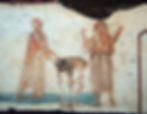Who's the Celebrant?
- The Rev. Christopher W. Whiteman
- May 13, 2022
- 4 min read
Updated: Aug 15, 2023

Dear Friends,
Do you ever wonder about what is going on Sunday mornings? I continually do and I think it is important to maintain an inquisitive spirit about how we worship, because if we are just performing ritual acts that we do not know the meaning of, they become things void of meaning. If we perform such empty acts for the sake of tradition, we risk obscuring what God is actually trying to do in those moments. Over the past year, we have talked about some of the ritual actions that occur in our sacred space, in particular the orans position and the laying on of hands. You can see both of these actions in the catacomb painting from the third century. In this vein of investigating our liturgy, I have been wondering how we as a community understand the making of eucharist.
When I stand behind the table on Sunday mornings, sunlight streaming in through the skylights above, I often wonder how my actions and even myself is perceived by the entire gathered community. How do we understand what a priest is doing during the eucharistic prayer? How de we understand what the rest of us in the building are doing during those moments?
Throughout the past two millennia, there have been many ways of understanding the roles of priest and congregation regarding the celebration of Holy Communion. The ideas cover a wide range from the minister simply offering a prayer while the congregation listens to the priest standing in the person of Christ as the congregation bears witness. During the middle ages, the role of the priest was elevated to such an extent that being a part of the congregation meant observing a man's back while he prayed in a foreign language, making various gestures, and then watching him be the sole recipient of the holy bread and sacred wine. Some branches of the Protestant Reformation offered a remedy by moving to the opposite end of the spectrum where the eucharist is a memorial that can be celebrated by anyone at anytime.
In Anglican thought, the understanding of the roles of the priest and the congregation has also changed over time and you would find widely differing opinions if you put a group of Episcopalians in a room and asked them these questions. This diversity of thought is, of course, one of the great strengths of our tradition, but it can lead to confusion and a lack of clarity. The way we worship–the way we connect with God and each other–is affected by how we understand what is actually happening in that moment.
In the 1979 Book of Common Prayer, the priest is named "Celebrant" in the eucharistic rites. The use of the word celebrant infers that this person is the central one who is doing things, making eucharist and the congregation watches as this happens. But is this really what is going on? Our theological stance is that a priest cannot celebrate a eucharist alone, but only in the presence of others. Therefore, the congregation is a necessary element of making eucharist and are not just mere spectators, but have a special role within this rite.
Louis Weil, a professor at Episcopal Seminaries for over fifty years and one of the architects of the 1979 Book of Common Prayer, in examining the roles of priest and congregation, writes:
Many people were, for example, accustomed to referring to the priest as "celebrant" at the Eucharist. But this custom was questioned when it was realized that all of the assembly, all of the gathered people, are the celebrants of the liturgy. The people are then active participants in the liturgical action rather than passive observers of what the clergy do. The role of the priest is therefore more of a "presider" over the liturgical action which all–the full assembly including clergy–are gathered to celebrate together (Weil, 15).
For Weil, the entire community is active in the celebration of our central rite. It is not one person performing an act, but a coming together of the body of Christ in praise and thanksgiving to make Christ's presence real among us.
I find Weil's argument compelling and beautiful. I imagine an entire community united in purpose and thought, one in desire and one in mission. I visualize the priest as the gatherer of threads–of each individual prayer–and offering them up to God in their collectiveness. I love this vision of people fusing together in their prayerful intention and for a moment becoming the aspirational body of Christ, a foretaste of Kingdom living. What a beautiful moment to experience and inhabit.
I invite you to live into your nature as celebrants of the eucharist, not merely spectators, but active participants. Be present in thought and intention as the presider offers up the community's prayer. Remember that you are essential to any liturgical action and it is more than just your presence. It is your prayer; it is our prayer. Live into Christ's embodiment around you and within you as we offer up bread and wine in thanksgiving and proclaim with vim and vigor the Great AMEN!
In Christ,
Christopher+




